Turtles are among the oldest reptiles alive today. They are known to have existed for more than 200 million years ago. There haven’t been many changes over those years. Other than being one of the oldest animals alive, they have the longest lifespan among all reptiles. It is not uncommon to find turtles living up to 100 years or more. There are even records of turtles that hit the 200th year mark!
Today, there are about 260 turtle species globally. In the US alone, there are over 100 different turtle species. Some are closely related in their appearance and behaviors, while others are very different.
Wisconsin is home to 13 turtle species. Below is a list of all turtles found in Wisconsin:
- Blanding’s
- Common Musk
- Common Map
- Eastern Spiny Softshell
- Common Snapping
- Midland Smooth Softshell
- False Map
- Midland Painted
- Ouachita Map
- Ornate Box
- Western Spiny Softshell
- Wood Turtle
- Western Painted
Of these, ten are water turtles, while one is a terrestrial turtle. We will outline each of these turtles, their appearance, behavior, and conservation status.
1. Blanding’s Turtle
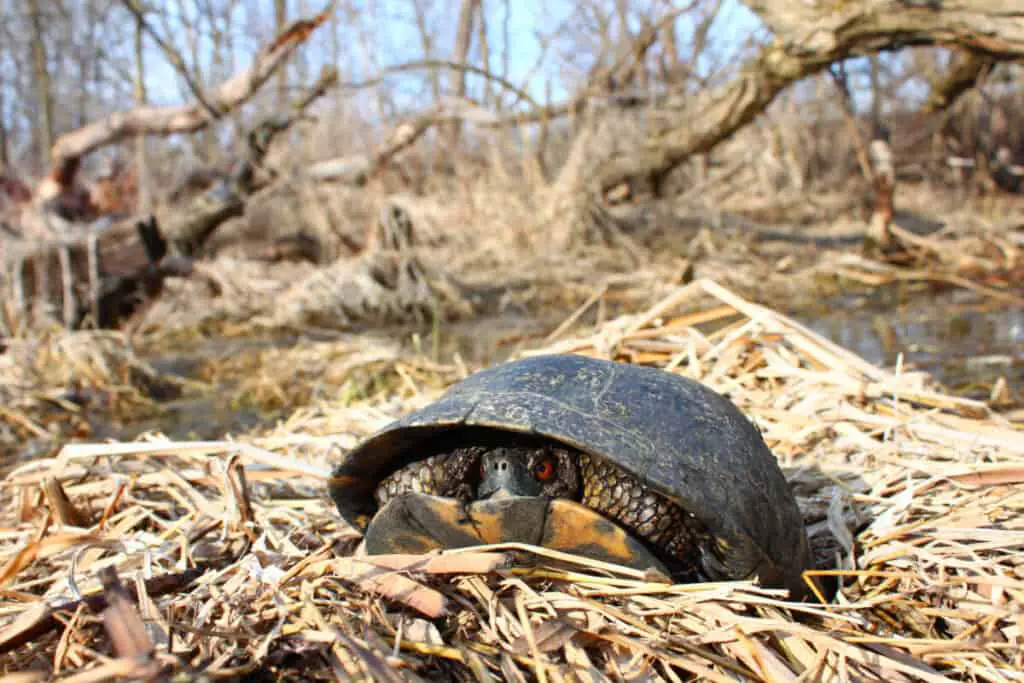
Scientifically, Blanding’s turtle is known as Emydoidea blandingii. It is a highly-domed turtle with a black or dark brown carapace (upper shell). Their skin is either dark brown or yellow, but the neck has a consistent yellow color in all species. The plastron (lower shell) is, in most cases, yellow but with multiple dark spots.
A Blanding’s turtle is mid-sized, attaining a length an average length of 7 inches.
Blanding’s turtle is aquatic and is common in shallow, slow-moving water with soft or loose floors. Some of the areas where you will find them include creeks, marshes, ponds, rivers, streams, and small lakes. Soft mud floors allow these turtles to burrow their bodies when hiding from predators quickly. They also prefer water bodies with a lot of vegetation for both food and cover.
Blanding’s turtle species are omnivorous, and their diet mainly consists of small fish, insects, invertebrates, aquatic vegetation, snails, and fruits. This turtle lives almost all its life in the water and seldom leaves for food or during reproduction time.
Reproduction in Blanding’s turtle takes place between May and September. A female turtle will lay between 6 and 15 fertilized eggs per clutch in a well-prepared nest. Incubation takes between 70 and 90 days. Hatchlings start emerging in late September or early October.
The lifespan of a Blanding turtle is 60-80 years.
In Wisconsin, it is one of the endangered species. Their main threats include predation, pet trade, and the destruction of their natural habitats to pave the way for urban development.
2. Common Musk Turtle
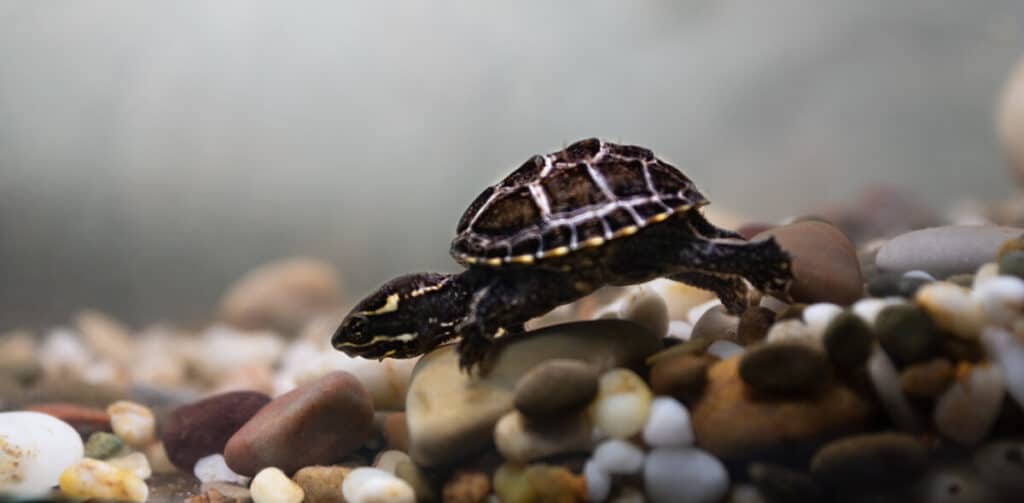
This turtle is also known as the Eastern musk turtle and goes by the Latin name Sternotherus odoratus. It is nicknamed “the stinkpot” owing to the pungent odor it produces from its musk glands when threatened. Common musk turtles are relatively small-sized sized, achieving a mere mature length of 3 to 5 inches.
Musk turtles have a plain carapace without a vertebral keel. Their carapace is either brown or black. A common identifying feature in these turtles is a light-colored stripe on each side of their eye.
Being aquatic, musk turtles are common in slow-flowing or still waters. Their habitat includes shallow lakes, small rivers, streams, creeks, and ponds. They also prefer water bodies with soft mud or sandy bottoms for ease of burrowing.
Common musk turtles, like most turtles, are omnivorous and will feed on small fish, insects, vertebrates, plants, carrion, earthworms, crabs, vegetables, and other aquatic plants.
The breeding season in these turtles starts in May and ends in September or early October. A female turtle usually lays between 1 and 9 eggs in a clutch. These eggs take on average about 75 days to hatch. Musk turtles take on average 3 to 4 years to mature sexually.
Their lifespan is about 50 years though some turtles have lived longer than that.
Conservation-wise, musk turtles are of little concern as their population is well-spread in Wisconsin. However, like with most turtles, human activities in their breeding grounds affect their breeding cycle, thus, affecting their population.
3. Common Map Turtle
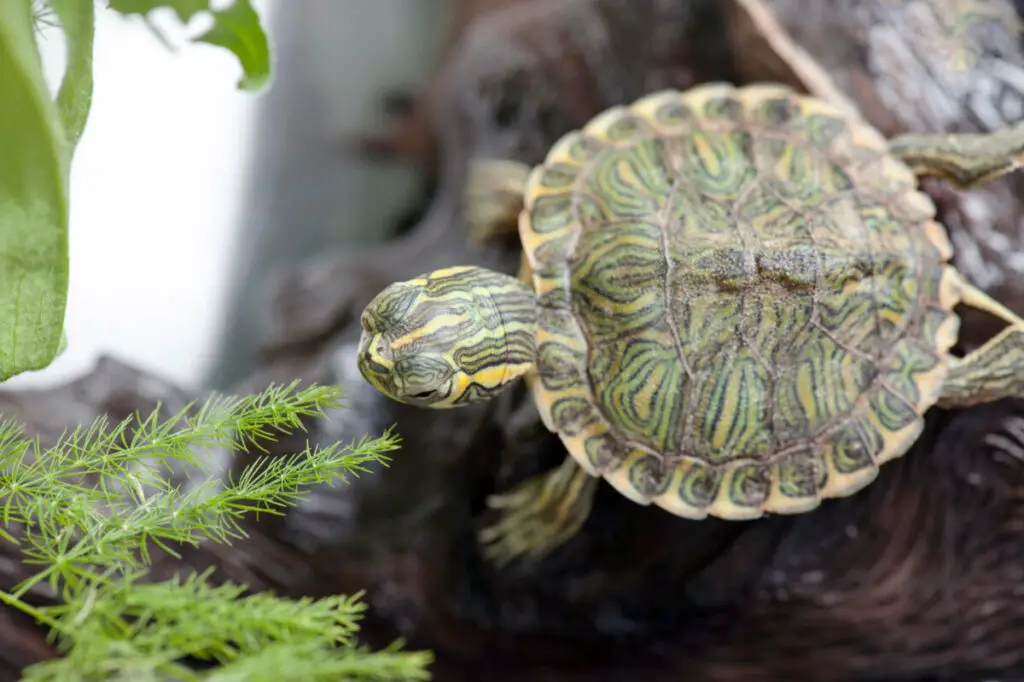
Scientifically, these turtles are known as Graptemys geographica. Their name comes from the map-like patterns on their carapace. They are either black or olive green, and the carapace has a slight vertebral keel while the scutes are saw-toothed. These features, however, fade with age.
The lower part has a similar color to that of the carapace but a lighter shade. Its skin is primarily olive green with numerous thin yellow stripes. They are mid-sized, achieving a mature age of up to 5 inches in males and 10 inches in females.
Map turtles are commonly found in slow-moving and at times stagnant water bodies. Their habitat includes rivers, ravines, creeks, ponds, marshes, and small lakes. They also prefer areas with dense vegetation cover for both food and protection.
Common map turtles are omnivores and feed on various meats like fish, insects, tadpoles, crabs, aquatic vegetation, and vegetables.
Map turtles reproduce from May to late September or early October. A female map turtle lays between 10 and 12 eggs in each clutch. In one year, these turtles may lay up to 3 clutches. After a female turtle lays eggs in a nest not far from the water, incubation takes commences, and it takes about 75 days.
Hatchlings’ sex depends on the temperature, with warmer temperatures favoring males. Males achieve sexual maturity by the 6th year, while females may delay up to the 10th year.
Map turtles have a lifespan of between 30 and 50 years.
In Wisconsin, map turtles are not considered endangered, and their population is well distributed all around the state.
4. Eastern Spiny Softshell Turtle
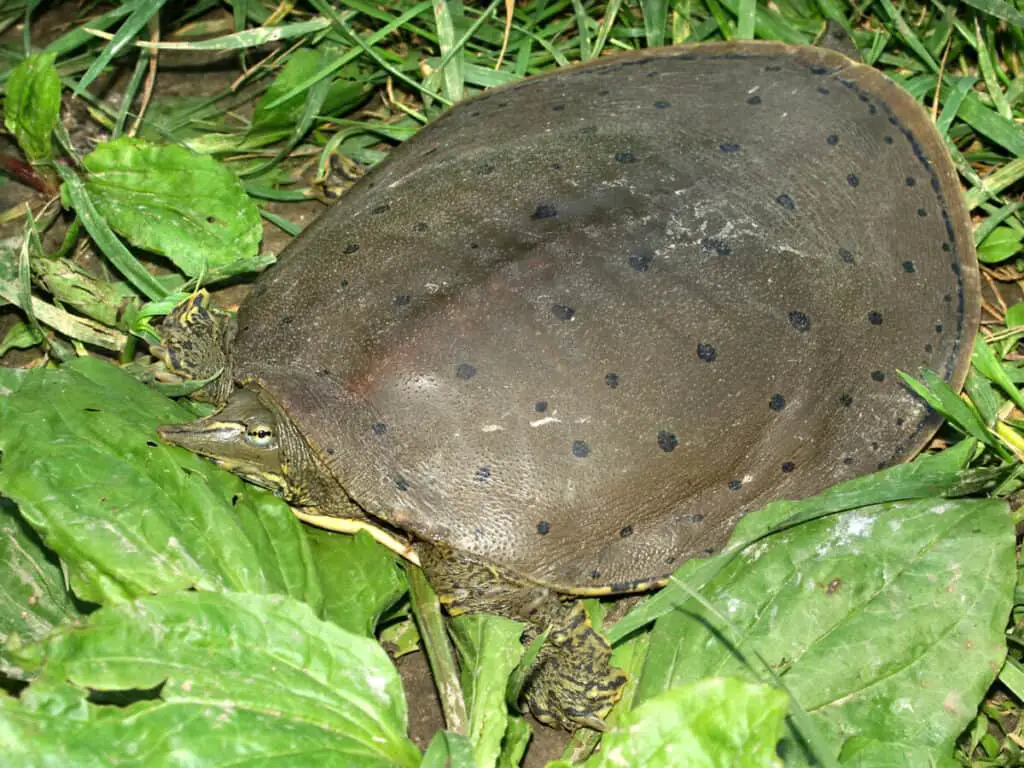
Scientifically, these turtles are called Apalone spinifera spinifera. As their name suggests, they are among the softshell turtles in Wisconsin. One of their identifying features is the large flattened and leathery shells as compared to other turtles.
They range from yellow-brown to olive-gray. The shells of these turtles have small dark spots that disappear as they age. Another identifying feature is a snout-like mouth- this is common in all softshells.
In terms of size, males grow up to 9 inches in length while females reach 20 inches.
Eastern Spiny softshells are more accustomed to large water bodies with a stronger current. They are common in large lakes, rivers, and streams. Other than the natural water bodies, you may also find them in large reservoirs.
These turtles are carnivorous, relying primarily on aquatic animals. Their diet comprises fish, insects, crabs, tadpoles, and other marine invertebrates.
Reproduction in eastern spiny softshell starts in May up to late September. Female turtles will lay between 4 and 40 eggs after fertilization in each clutch. Incubation takes about 80 to 90 days, and hatchlings start emerging towards the end of August.
Unlike other turtles, eastern spiny softshell hatchlings cannot survive the winter in their nests. They must reach a water body and overwinter there.
While it is not considered a threatened turtle, its population has declined due to predation and human habitat destruction. The lifespan of eastern spiny softshell is about 40 to 70 years in the wild.
5. Common Snapping Turtle
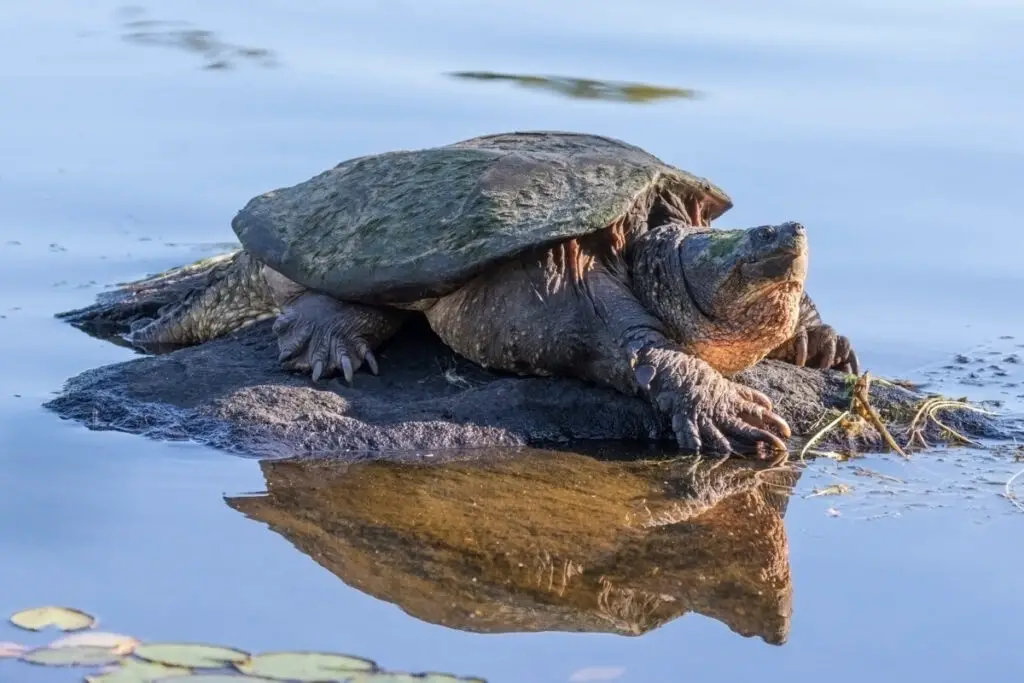
The biological name for this turtle is Chelydra serpentina serpentina. They are either black or brown with unusually long legs, tails, and necks. As with other snapping species, their carapace is unkeeled and serrated towards the rear end.
Their mouth assumes a beak-like shape and has powerful jaws. Common snapping turtles can cause serious harm through their bites if not handled carefully.
These turtles are medium-sized, achieving between 12 and 15 inches when mature. There are rare cases of turtles measuring 19 inches.
Like most turtles, they are aquatic, common in any water body with a muddy floor or loose sand. They inhabit ponds, streams, rivers, lakes, marshes, and other similar water bodies.
Common snapping turtles are omnivorous, and their diet comprises fish, frogs, insects, crabs, crustaceans, vegetables, vegetation, and other aquatic plants. They will either scavenge actively hunt for the food. At times, they lay in wait at the bottom of the ocean and pounce on unsuspecting prey.
Reproduction in common snapping turtles starts when the turtles are at least 8 inches in length or between ages 8 and 10 years. The reproduction period may vary, but in Wisconsin, it falls between April and November. Female turtles lay eggs between April and June. Incubation then takes about 80 to 90 days, and hatchlings start emerging in late August.
The temperature in the nest greatly influences the hatchlings’ gender. A temperature below 680 F favors females while 700 to 720 F leads to an even number of males and females; above 720 F, more males are produced.
The lifespan of snapping turtles is about 50 years.
In matters conservation, common snapping turtles are of least concern. However, there is a growing demand as their meat is gaining popularity. In Wisconsin, one is not allowed to collect snapping turtles from the wild.
6. Midland Smooth Softshell
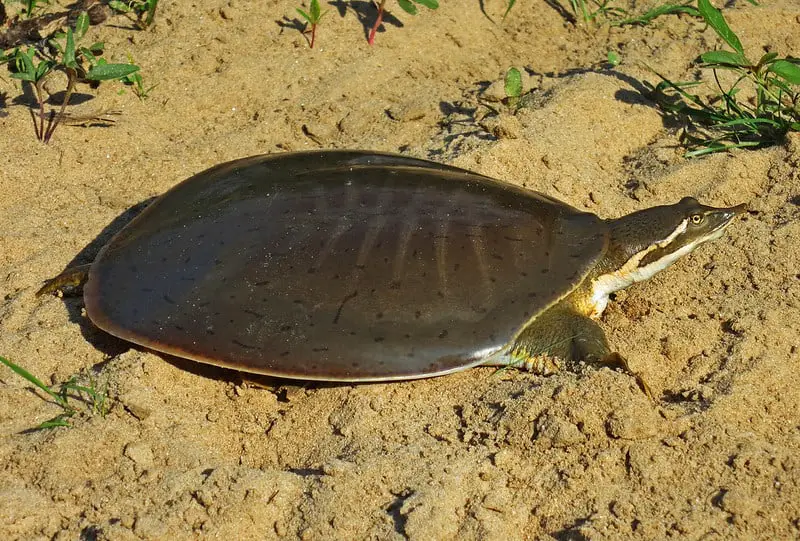
The Biological name for this turtle is Apalone mutica mutica. Their shell is plain-looking without any distinct features or patterns. As the name suggests, they also have a smooth flat upper shell that is unkeeled.
The carapace is either olive-gray or brown, while the lower side of the turtle has a light gray color. The underside of the turtle’s limbs and neck is cream-colored. It also has a distinct light-colored stripe running behind each eye.
Midland smooth softshell turtles are medium-sized-achieving a length of between 6 and 13 inches when mature. Female turtles are slightly larger than males.
These turtles are aquatic, and they prefer water bodies with soft or sandy floors. In Wisconsin, Midland smooth softshell turtles can be found in ponds, creeks, rivers, and streams. Since these turtles are great swimmers, they spend most of their lives is spent in the water.
Like many other turtles, the Midland smooth softshell turtle is omnivorous but leans heavily towards meat than plants. Their diet mainly consists of insects, fish, crabs, snails, tadpoles, and other invertebrates. Occasionally, they may also feed on fruits, vegetables, and different kinds of aquatic plant life available.
Reproduction in Midland smooth softshell turtles occurs between May and September. Sexual maturity in these turtles is achieved by the fourth year for the male turtles, while females reach it by the 9th year.
A female turtle will lay between 5 and 35 eggs each clutch. It takes between 60 and 100 days for them to hatch. Hatchlings start emerging from their nest in late August or early September in search of a water source.
The lifespan of a Midland softshell turtle is about 60 years.
Their population in Wisconsin is stable, meaning they are not under any immediate threat.
7. False Map Turtle

Biologically, false map turtles are called Graptemys pseudogeographica. They are small to mid-sized turtles with mature males measuring between 3 and 5 inches while females grow to between 8 and 10 inches.
Their carapace is either black, brown, or olive but with dark patches with thin yellow lines around them. They also have a prominent vertebral keel that disappears as the turtle ages.
They are called false map turtles due to the map-like resemblance of their shells. Their patterns are, however, different from those of map turtles. On the other hand, the plastron is yellow, while the skin is olive with numerous thin yellow or white stripes.
False map turtles are aquatic and common in stagnant or slow-flowing water bodies with dense vegetation. They inhabit rivers, ponds, lakes, marshes, and streams.
These turtles are omnivores, and their diet is mainly composed of fruits, aquatic vegetation, vegetables, insects, invertebrates, crabs, and other small aquatic animals.
Reproduction in False map turtles occurs twice each year, the first time from April and then in late October or early November. After mating, female turtles lay eggs from mid-May to June. False map turtles may lay up to 2 to 3 clutches each year, each containing between 10 and 20 eggs. Incubation then starts almost immediately and lasts for 60 to 90 days. False map turtles achieve sexual maturity between ages 4 and 6 in males, while it takes between 8 and 14 years in females.
The lifespan of these turtles is between 30 and 35 years, which is considerably shorter than other turtles.
In Wisconsin, the false map turtles’ population is stable, meaning they are not under any threat of extinction.
8. Midland Painted Turtle
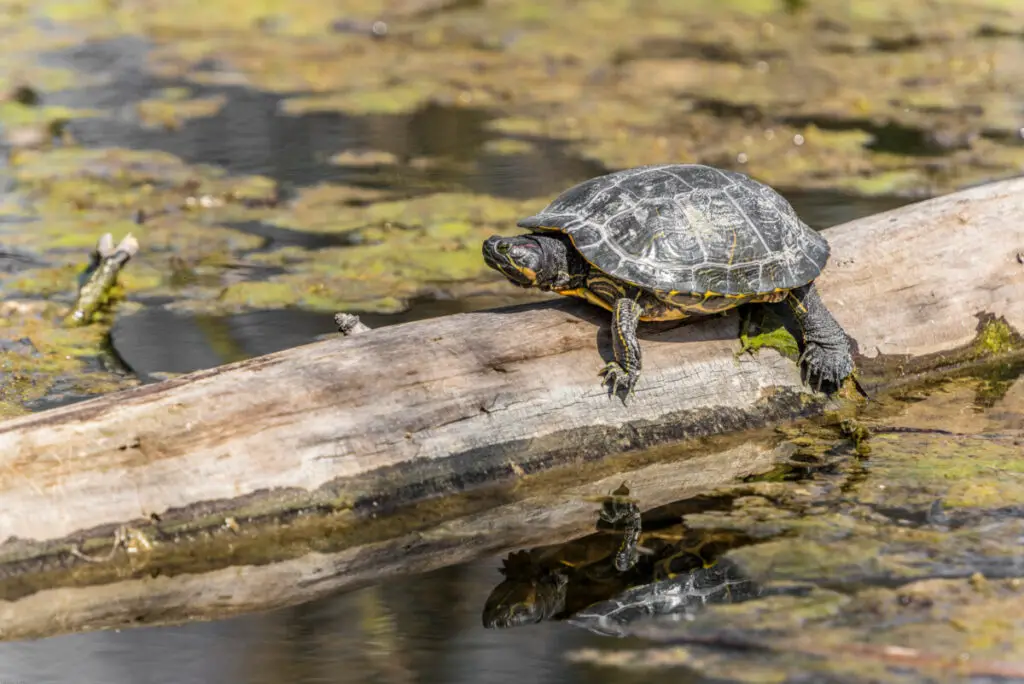
The scientific name for Midland painted turtles is Chrysemys picta marginata. Their carapace is dark-colored, smooth, and without a vertebral keel. It also has thin red or yellow line-markings. The plastron is yellow, while the skin is dark olive or black with tin yellow or red stripes running down its neck.
Mature Midland painted turtles measure between 5 and 7 inches in length.
Midland painted turtles are aquatic and spend almost all their lives in slow-flowing or stagnant water bodies like all other painted turtles. Their habitat comprises ponds, rivers, marshes, small lakes, and large streams.
They feed on both aquatic plant and animal life. As with other omnivores, their diet comprises insects, small fish, crabs, fruits, vegetables, and aquatic vegetation.
These painted turtles reproduce between March and September. Females will lay eggs between May and July. On average, a female turtle will lay about seven eggs in each clutch. They lay them in a nest that is about 10 cm deep.
Incubation in these turtles takes about 60 to 90 days. Once the hatchlings emerge, they will leave the nest immediately and head towards the nearest water bodies. Sexual maturity in midland turtles is achieved by the 6th year in males, while in females, it may delay up to the 10th year.
On average, Midland painted turtles will live for only 20 to 30 years.
In Wisconsin, midland painted turtles are categorized as least concern species because they currently have stable populations. However, human activities around the nesting sites interfere with the breeding patterns, and if left unchecked, it may leave their population in jeopardy.
9. Ouachita Map Turtle
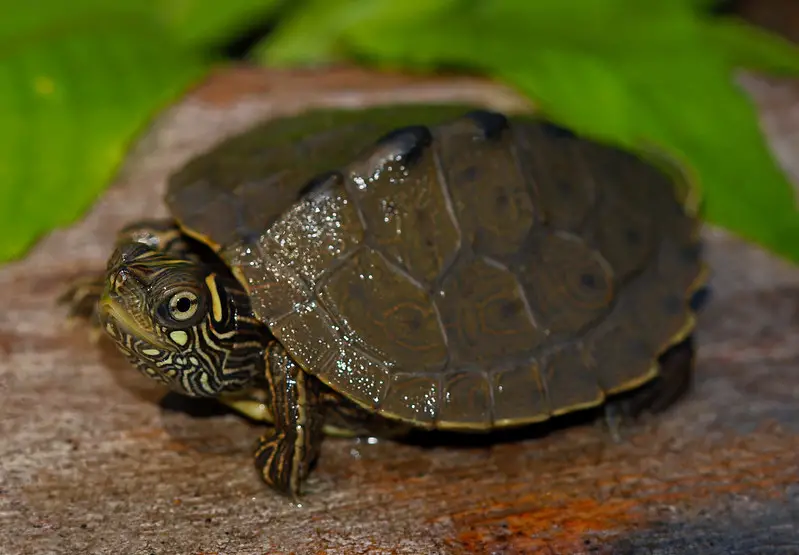
Scientifically, Ouachita map turtles are known as Graptemys ouachitensis. They are named after a Native American tribe that lived in the Northeastern part of Louisiana. These turtles are a subspecies of the map turtles, meaning they share some of their features with other map turtles.
They are relatively small, with the males only achieving a maximum length of 5 inches. Females, however, grow slightly taller and may achieve up to 10 inches.
Their carapace is either brown, olive, or black, while the lower part is usually yellow. The skin, limbs, and neck of these turtles are olive with thin yellow or white stripes. Their carapace has a prominent vertebral keel that fades as the turtle ages. It is also serrated at the edges.
Ouachita map turtles are common in stagnant or slow-flowing water with dense vegetation for both food and cover. They also prefer those water bodies whose floors are either soft mud or loose sand.
Like most other turtles, they are omnivores and feed on insects, mollusks, frogs, tadpoles, crabs, carrion, aquatic vegetation, and fruits.
Courtship and mating in Ouachita map turtles happen from May through July. Each year, a female Ouachita turtle will lay up to three clutches, each clutch containing between 10 and 20 eggs. It takes the eggs between 60 and 80 days to hatch. Hatchlings will start emerging in late August or early September.
Before laying her eggs, a female turtle will dig several false nests to confuse the would-be predators like raccoons. Sexual maturity occurs by the 6th year in males and by the 10th year in females.
These turtles have a relatively short life, on average. Their lifespan is about 20 years.
Ouachita map turtles are under least concern in the conservation list. In Wisconsin, you will require a state-issued permit to own any of the five map turtle species.
10. Ornate Box Turtle
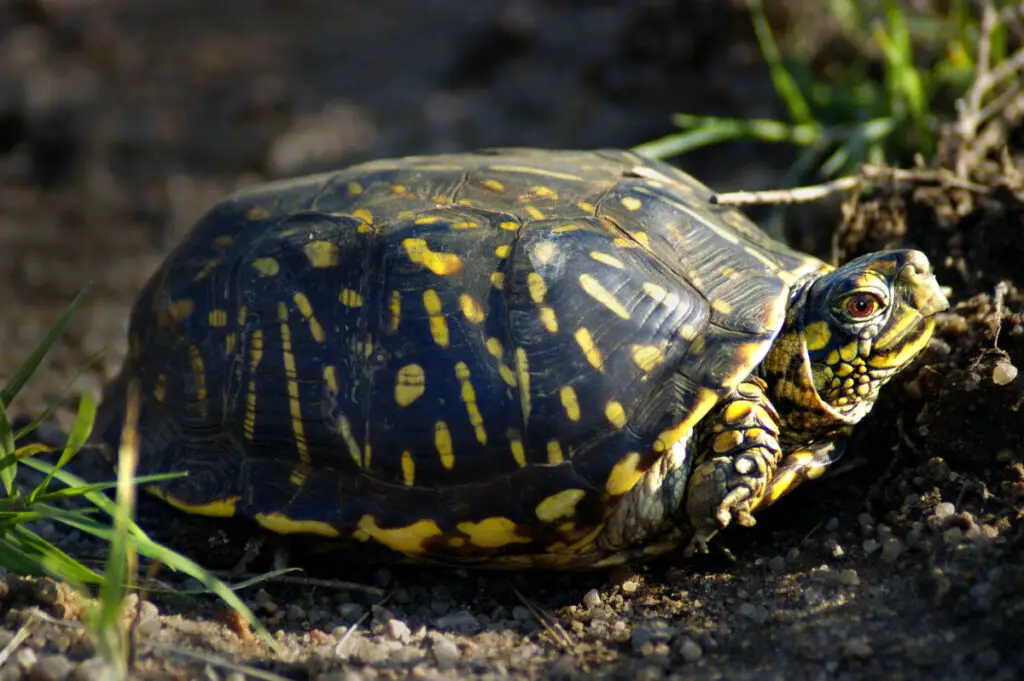
Scientifically, these turtles are known as Terrapene ornata ornata. Like other box turtles, ornate box turtles have a highly-domed and unkeeled carapace. Their colors range from olive to brown or black. The carapace is covered in many yellow lines, and the lower shell is yellow while their skin is the same color as the carapace; the only difference is yellow stripes.
Ornate box turtles are medium-sized turtles; adult turtles measure between 5 and 7 inches long.
Unlike most other turtles here, box turtles are terrestrial, meaning they spend most of their time on land. They are common in the open grasslands, woodlands, and meadows with deep sandy soils.
Further, their diet comprises both meat and plants. They commonly feed on beetles, grasshoppers, caterpillars, carrion, fruits, berries, small rodents, birds, and vegetation.
Reproduction in ornate turtles starts in May and ends in September. Mating and egg-laying happen between May and July. A female turtle will lay four eggs in a clutch. It takes the eggs about 60 and 90 days before they hatch. Sexual maturity occurs when the turtle is between 7 and 10 years old.
Ornate turtles have a lifespan of about 40 years.
Although these turtles are terrestrial, they still hibernate like most aquatic species. Hibernation is induced once the temperature falls below 500 Fahrenheit. It starts in mid-September or early October and lasts for up to four months. Newly hatched ornate box turtles do not hibernate, and most perish due to the harsh winter conditions.
In matters of conservation, ornate box turtles are listed as endangered species in Wisconsin. The main reasons for population decline are habitat destruction to pave the way for roads, converting their habitat to agricultural land, and people adopting them as pets. Due to this, it is illegal to own an ornate turtle in Wisconsin unless you have a permit.
11. Western Spiny Softshell
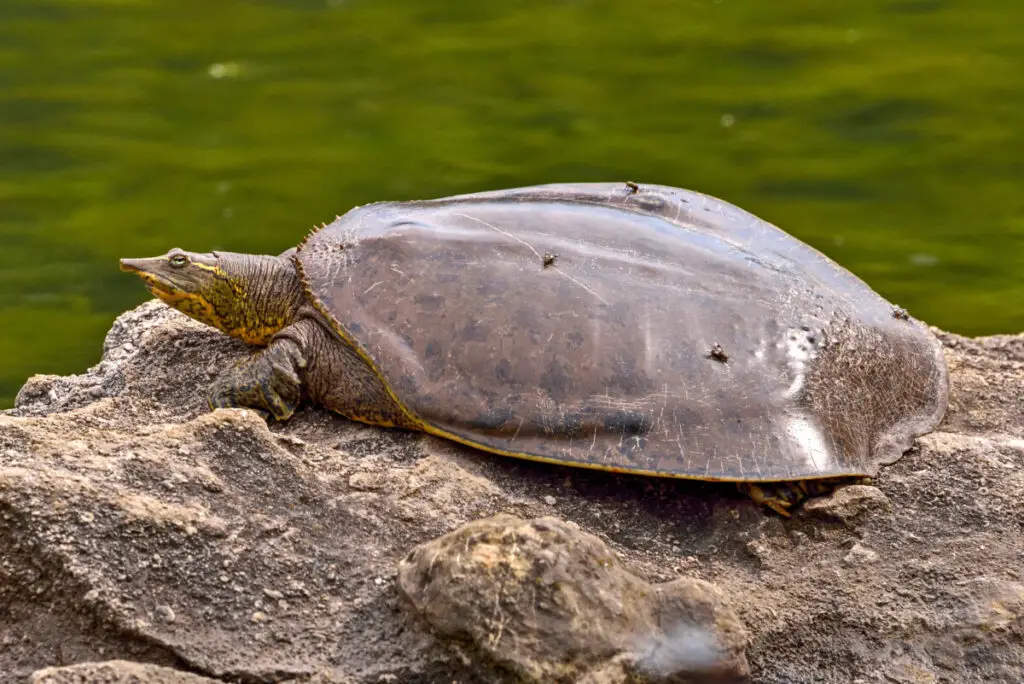
The Latin name for the Western Spiny softshell turtles is Apalone spinifera hartwegi. They are a sub-species of softshell turtles whose appearance is closely related to the smooth softshell turtle. A distinctive feature is two thin yellow lines on each eye.
Its carapace has a row of spines on the edges. Young and male turtles have olive or gray carapaces with dark doughnut-like spots, while the female adult ones have a tan or dark olive carapace. They have thin, snout-like mouths with c-shaped nostrils. Their skin is olive-gray with numerous small dark spots.
Adult males measure between 5 and 10 inches, while females measure between 9 and 20 inches.
Western spiny softshell turtles are aquatic and are common in large reservoirs, shallow rivers and lakes, marshes, and wetlands with muddy or sandy floors. The young turtles spend much of their time burrowed on these floors laying in wait for prey.
Spiny softshells are carnivorous, and their diet consists of aquatic insects, snails, carrion, small fish, crustaceans, and invertebrates.
Sexually, spiny softshell turtles are active from four years in males and seven years in females. Each year, a female spiny softshell will mate and lay between 10 and 20 eggs between May and June. It takes about 60-90 days for the eggs to hatch. The temperature of the nest determines the hatchlings’ gender.
Western spiny softshell turtles can be aggressive, and if not well handled, they may cause serious bites.
In Wisconsin, spiny softshell turtles are not considered an endangered species. However, there has been a decline in their population due to human activities in their habitats.
12. Wood Turtle
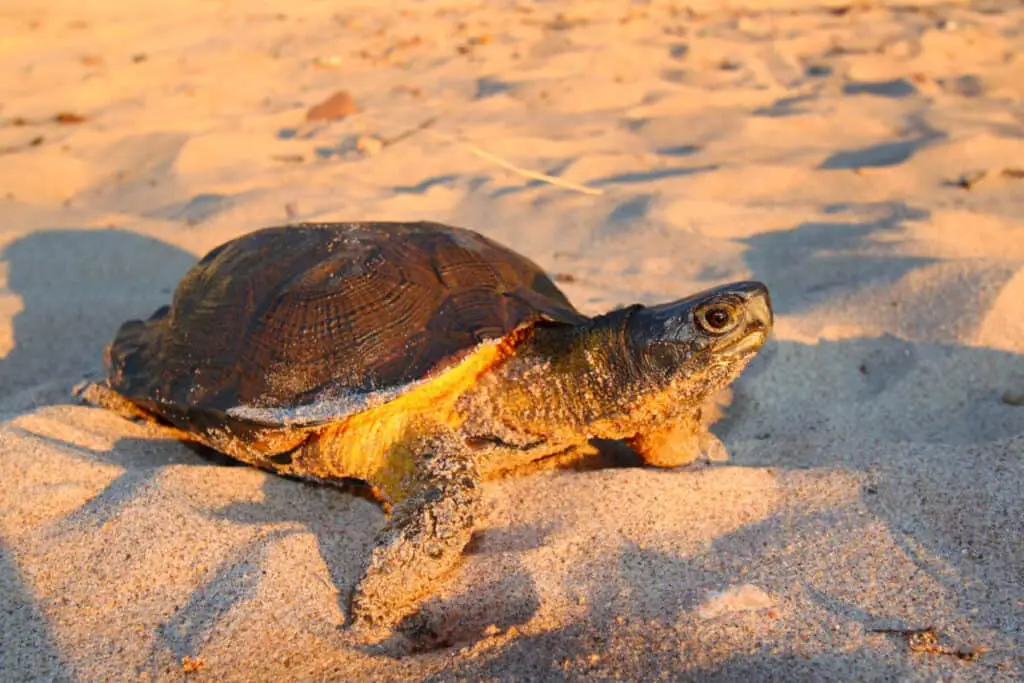
Their name is derived from the wood-like patterns on its carapace. The patterns look like wood grains and growth rings. Scientifically, they are called Glyptemys insculpta.
The carapace is slightly-domed and flattened toward the edges. It is also brown or gray, while the plastron is yellow. The upper part of the turtle’s head and limbs are black, while the lower sides are orange-yellow.
These turtles are mid-sized, with an adult turtle reaching an average length of between 5 and 9 inches.
Wood turtles are aquatic turtles that reside near streams, rivers, woodlands, marshes, and ponds near forests. They prefer habitats with dense vegetation.
Further, they are omnivorous but heavily lean towards plants as opposed to meat. They consume lots of blackberries and strawberries, raspberries and blueberries, and occasionally a few snails and insects.
The reproduction period in wood turtles starts in May and September when the young ones hatch. Female wood turtles lay between 4 and 12 fertilized eggs in a clutch. They dig their nests just a few meters from the river banks on loose sandy soils and deposit the eggs.
Incubation in these turtles takes about 80 days. When the hatchlings emerge, they may swim towards water or decide to overwinter there. Sexual maturity in wood turtles happens later than in most turtles, at 15 to 20 years.
Their lifespan is between 40 and 60 years.
In Wisconsin, wood turtles are classified as a threatened species. The main threats include habitat loss or fragmentation and road mortality when the turtles are searching for a new habitat. The fact that these turtle experiences delayed sexual maturity also contributes to the decline in population.
13. Western Painted Turtle
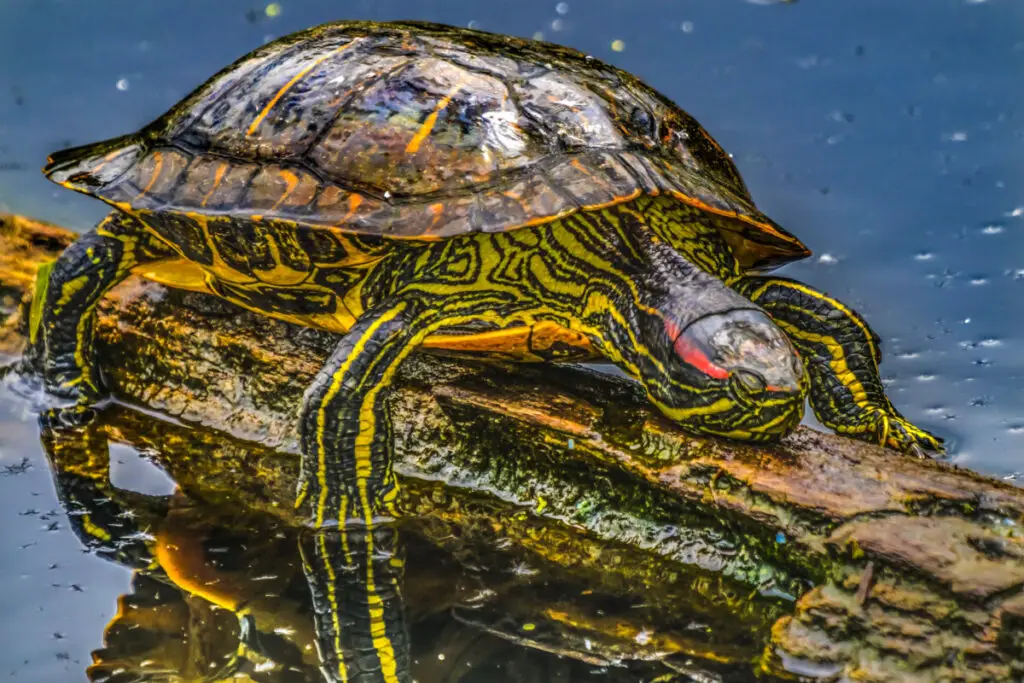
The scientific name for the western painted turtles is Chrysemys picta bellii. They have a smooth carapace ranging from black to olive. Towards the edges, the carapace has orange, red, or yellow markings. It also lacks a vertebral keel.
The lower shell is red or orange with large or multiple dark markings at the center. The skin is olive with multiple yellow stripes. The turtle’s neck is olive with yellow lines, while the limbs are olive with yellow markings. A mature western painted turtle measures between 5 and 7 inches.
Western painted turtles are common in shallow, slow-flowing freshwater bodies and prefer water bodies with loose sandy or muddy floors for ease of burrowing. These turtles are common in rivers, large streams, lakes, and ponds surrounded by dense vegetation.
They are omnivores, and their diet comprises insects, carrion, invertebrates, small fish, aquatic vegetation, vegetables, and algae.
Reproduction in Western painted turtles occurs from May to late August or early September. A female turtle will dig a nest using her hid legs and lay about 10 to 12 eggs per clutch each year. On average, these turtles will lay about two clutches each year. The nests must be in a good location with sufficient moisture and warmth, usually less than 200 meters from the water.
Incubation in Western painted turtles takes between 70 and 80 days. Hatchlings start emerging in late August or early September. Not all hatchlings will leave the nest; some may decide to overwinter for about four months.
Sexual maturity in Western painted turtles occurs earlier in males than females. A male turtle will take about six years, while female turtles may take up to 13 years.
The lifespan of a Western painted turtle is 60 years in the world.
In Wisconsin, the western painted turtle has a stable population. It is said to be the most abundant turtle in this state.
Wisconsin Turtle Laws
In every state in the US, there are laws to govern the interaction between people and turtles. Wisconsin is no different and below are the laws that apply to owning turtles:
· Maximum Turtles per Species
The state limit for owning all native turtles that are protected is five turtles per turtle species. An exception here is the softshell turtles and the snapping turtles, whose limit is three. There is also an exception for those around the Mississippi river who can own up to five softshell turtles and ten snapping turtles.
There are no restrictions for owning nonnative turtles, and this applies to both the state residents and non-residents.
· Protected turtle species
The following turtle species are protected in Wisconsin; wood turtle, ornate box, and Blanding’s species. It is illegal to own, sell or capture these species from the wild. Dealing of any kind with the three species is federally outlawed.
However, in Wisconsin, one may be allowed to sell a naïve turtle without a license provided that the turtle is not under any threat.
· Native Turtles Outside Wisconsin
In a bid to protect her native turtle population, Wisconsin laws prohibit the sale of live native turtles to the outside. One can only sell native turtles within the state.
· Collection From The Wild
Anyone who collects and possesses native turtles from the wild will require a fishing or small game license. One is not allowed to collect the protected or endangered species in the state. Similarly, the commercial sale of native turtles is outlawed.
· Open Season
In Wisconsin, the open season happens between July 15 and 30th November. It is illegal to collect turtles or turtle eggs outside this season. One may, however, own as many nonnative turtles as they wish without requiring a license.
· Owning Snapping Turtles
To own a snapping turtle, its carapace needs to measure between 12 and 16 inches long. It is unlawful to possess a snapping turtle bigger or smaller than the recommended measures. There are no length limitations for other turtles.
· Commercial Exhibition of Native and Nonnative Turtles
In Wisconsin, it is legal to collect and exhibit nonnative turtles for commercial purposes without requiring a license from the Department of Natural resources. This means that nonnative turtles collected from the wild can be used for commercial purposes.
When it comes to native turtles, residents and non-residents are allowed to exhibit but not sell native turtles, but they will require a license to do this.
· Captive Wild Farm License
This license enables the holder to own, breed and kill, purchase or sell captive wild turtles specified on the permit. This, however, applies to only those turtles obtained from legal captive sources. It does not apply to the turtles in the wild. Also, the turtles may only be sold to the people authorized on the license.
· Turtle Handling Tools
There are several tools that turtle handlers should use whenever they are hunting for or handling turtles. These tools include hook and line, dip net, hoop net trap, set or bank poles, and set lines. Such tools are meant to ensure that turtles are handled in a human.
Conclusion
There is diversity in turtle species in Wisconsin. Of the 13 turtle species found in the state, one is terrestrial, while two are endangered. A great contributor to the decline in population numbers is human activities in the turtle habitat leading to the destruction of the turtles’ habitat.
While the above turtle laws have been put in place to protect turtles, they are not very effective since they are not implemented well. One of the reasons this is so is people are not enlightened about the need to take care of turtles. Most people are not concerned about how their actions are affecting the turtle population.
As such, it is crucial to create awareness of the need to conserve turtles. Doing so will help people realize that their actions are impacting turtles negatively. A collaboration between the state and movements or organizations seeking to protect turtles’ welfare can help achieve this. As an individual, you can help by joining such organizations or reporting to authorities’ people’s actions that are causing harm to turtles in the wild.